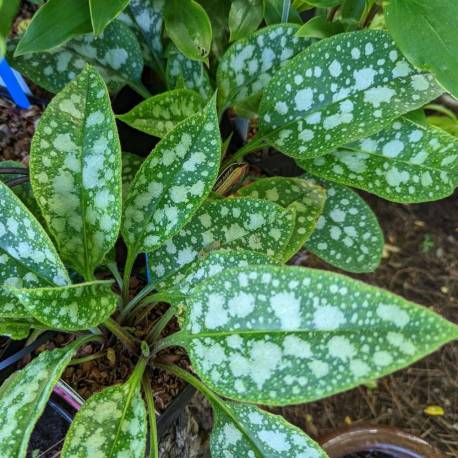No products
Product successfully added to your shopping cart
There are 0 items in your cart. There is 1 item in your cart.
A perennial herbaceous shade plant, it has pink and blue flowers together, it has silver-white spots on the leaves which makes it very ornamental throughout the growing season even after the spring flowering.
La pianta è in vaso di 14-16 cm di diametro
75 Items
A perennial herbaceous shade plant, it has pink and blue flowers together, it has silver-white spots on the leaves which makes it very ornamental throughout the growing season even after the spring flowering.
Pulmonaria: from the Latin "púlmo, pulmónis", lung: plant used to treat lung diseases.
There was a belief that plants of the Pulmonaria genus cured lung problems, due to the presence of white spots on the leaves that resembled those on the lungs of tuberculosis patients.
Magnificent perennial undergrowth plant, perfect contour to ferns, hellebores, epimedium, geranium, liriope, carex, hosta.
The plants grow quickly. The beautiful foliage interesting for most of the year is also useful in pots and flower boxes, to enrich shady corners with light.
Classification
Common name: Lungwort, Wild Borage, Jerusalem Sage.
Genus and species: Pulmonaria saccharata
Family: Boraginaceae.
Characteristics
Flower description: Flowers of about 1 cm in diameter, with 5 lobes, funnel-shaped, in bunches.
Flower color: Pink in bud and intense cobalt blue when open, so that on the plant there are pink and blue flowers at the same time.
Flowering period: Spring.
Leaves: Arranged in rosettes, semi-evergreen, hairy, elongated and lanceolate, up to 30 cm long, with the surface dotted with silver spots.
Fragrance: -
Dimensions: Height 30 cm and width about 60 cm.
Cultivation
Exposure: Partial shade, shade.
Soil: Any, but well drained.
Irrigation: As needed, without excess.
Frost hardiness: USDA 3
Care
Pruning: Periodically clean the basal leaves that dry and die. Remove the faded tops to prolong flowering.
Propagation: It is propagated by dividing the tufts in autumn.
Notes of interest
Use in cooking: Contains vitamin C, carotene and antioxidants. The flowers are edible, they can be added to salads. The leaves can also be eaten raw or cooked depending on personal taste; being hairy and mucilaginous (therefore a little slimy once cooked) they can be unpleasant if eaten alone.
Herbal properties: Emollient, expectorant, astringent, anti-inflammatory, vulnerary.
It is used in the treatment of coughs and bronchitis. The other large area is that relating to its astringency: help for irritated intestines and to heal wounds. Pour 1-2 teaspoons of dry herb into a cup of boiling water and leave to infuse for 10-15 minutes. Drink or use for local compresses.

















